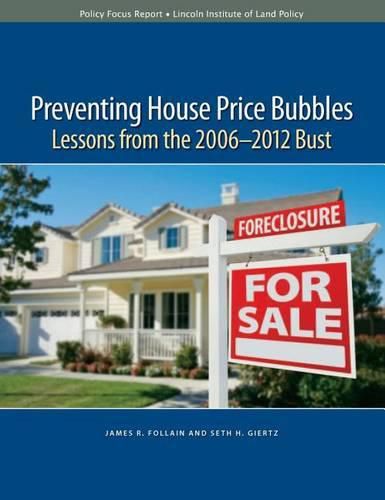Preventing House Price Bubbles - Lessons from the 2006-2012 Bust
James R. Follain,Seth H. Giertz

Preventing House Price Bubbles - Lessons from the 2006-2012 Bust
James R. Follain,Seth H. Giertz
The recent boom and bust in house prices generated widespread fallout, affecting metropolitan areas across the country. But the extent of the damage varied widely, suggesting that local market conditions also played an important role in determining how the crisis played out. As a result, national aggregates were an unreliable guide to both housing performance and the design of policies to mitigate the crisis.
Based on their recent research for the Lincoln Institute, James R. Follain and Seth H. Giertz document how econometric models can be used to address some of the complex issues that have arisen since the house price bust. In particular, these models provide valuable insights into the interrelationships between house price patterns and their drivers-including new drivers that changed the fundamental dynamics of housing markets, such as the size of the distressed real estate inventory, the pace of price appreciation, and the amount of subprime lending.
These changes made policymaking in mid-crisis especially challenging. To illustrate this point, the authors analyze one of the major programs put in place to stem the spread of foreclosures. The Housing Affordable Modification Program (HAMP) was developed in 2007 just as the destructive fallout of the crisis began to appear. Traditional tools for measuring and managing the crisis were insufficient. The design of HAMP thus rested upon a number of critical judgments about borrower and lender behavior made without benefit of strong empirical support. While recognizing the challenges of responding to a bust once it has begun, the authors suggest that attempts to deal with any future crises of this type would benefit from certain different design decisions:
* an initial focus on hardest-hit markets to fine-tune program parameters, * development of longer-term forecasts of house prices for local markets, * greater efforts to foster more cooperation among all levels of government, and * fuller recognition of the inherent weaknesses of securitization.
The report then discusses how econometric results can also be used to identify and prevent, or at least limit, the formation of future house price bubbles. Analysts often mention two specific options for combating unsustainable price increases: monetary policy and countercyclical capital policies. Follain and Giertz argue that monetary policy is of limited use in this arena, given that price appreciation varies so widely across local markets. Countercyclical capital buffers-which would raise capital requirements for financial institutions during the initial stages of the price bubble and reduce them during the period of decline-are a much more promising policy direction because they could be designed to put the brakes on only in those markets where bubbles appear to be developing. The growing availability of geographically granular data make this approach to bubble prevention much more viable than in the past.
This item is not currently in-stock. It can be ordered online and is expected to ship in approx 4 weeks
Our stock data is updated periodically, and availability may change throughout the day for in-demand items. Please call the relevant shop for the most current stock information. Prices are subject to change without notice.
Sign in or become a Readings Member to add this title to a wishlist.


